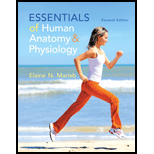
Essentials of Human Anatomy & Physiology (11th Edition)
11th Edition
ISBN: 9780321919007
Author: Elaine N. Marieb
Publisher: PEARSON
expand_more
expand_more
format_list_bulleted
Question
Chapter 2, Problem 14SAE
Summary Introduction
To review:
The kind of energy involved in chewing food, sending a nerve impulse, bending the fingers to make a fist, and breaking the bonds of adenosine triphosphate (ATP) to energize muscle cells while making a fist.
Introduction:
The ability to perform or conduct any kind of work is known as energy. It has no mass and occupies no space in the universe. Energy is always associated with matter. Energy may be converted into various forms, but the parent energies are potential and kinetic energies.
Expert Solution & Answer
Want to see the full answer?
Check out a sample textbook solution
Students have asked these similar questions
Please draw in the missing answer, thank you
Please fill in all blank questions, Thank you
please fill in missing parts , thank you
Chapter 2 Solutions
Essentials of Human Anatomy & Physiology (11th Edition)
Ch. 2 - Prob. 1MCCh. 2 - Prob. 2MCCh. 2 - Prob. 3MCCh. 2 - Prob. 4MCCh. 2 - Glucose is to starch as a. a steroid is to a...Ch. 2 - 6. What lipid type is stored in fat deposits...Ch. 2 - Absence of which of the following...Ch. 2 - ATP is not associated with a. a basic nucleotide...Ch. 2 - Prob. 9MCCh. 2 - 10. Factors that increase the speed of chemical...
Ch. 2 - Why is a study of basic chemistry essential to...Ch. 2 - Matter occupies space and has mass. Explain how...Ch. 2 - Prob. 13SAECh. 2 - Prob. 14SAECh. 2 - Prob. 15SAECh. 2 - Prob. 16SAECh. 2 - All atoms are neutral. Explain the basis of this...Ch. 2 - Fill in the following table to fully describe an...Ch. 2 - Define radioactivity. If an element has three...Ch. 2 - Prob. 20SAECh. 2 - Prob. 21SAECh. 2 - Where would you expect to Find hydrogen bonds in...Ch. 2 - The two oxygen atoms forming molecules of oxygen...Ch. 2 - Prob. 24SAECh. 2 - 25. Identify each of the following reactions as a...Ch. 2 - Prob. 26SAECh. 2 - Prob. 27SAECh. 2 - 28. Define pH. The pH range of blood is from 7.35...Ch. 2 - Prob. 29SAECh. 2 - Prob. 30SAECh. 2 - Describe the structural differences between...Ch. 2 - Prob. 32SAECh. 2 - 33. Name the two protein classes based on...Ch. 2 - Prob. 34SAECh. 2 - Describe what has happened to a proteins structure...Ch. 2 - Prob. 36SAECh. 2 - Prob. 37SAECh. 2 - 38. Explain why you can “stack” water slightly...Ch. 2 - Explain what is meant by the terms synthesis...Ch. 2 - 41. Several antibiotics act by binding to certain...Ch. 2 - 42. Mrs. Roberts, who is in a diabetic coma, has...Ch. 2 - Tendons, ligaments, and skin contain a large...Ch. 2 - Prob. 43CAQ
Knowledge Booster
Similar questions
- please draw in the answers, thank youarrow_forwarda. On this first grid, assume that the DNA and RNA templates are read left to right. DNA DNA mRNA codon tRNA anticodon polypeptide _strand strand C с A T G A U G C A TRP b. Now do this AGAIN assuming that the DNA and RNA templates are read right to left. DNA DNA strand strand C mRNA codon tRNA anticodon polypeptide 0 A T G A U G с A TRParrow_forwardplease answer all question below with the following answer choice, thank you!arrow_forward
- please draw in the answeres, thank youarrow_forwardA) What is being shown here?B) What is indicated by the RED arrow?C) What is indicated by the BLUE arrow?arrow_forwardPlease identify the curve shown below. What does this curve represent? Please identify A, B, C, D, and E (the orange oval). What is occurring in these regions?arrow_forward
- Please identify the test shown here. 1) What is the test? 2) What does the test indicate? How is it performed? What is CX? 3) Why might the test be performed in a clinical setting? GEN CZ CX CPZ PTZ CACarrow_forwardDetermine how much ATP would a cell produce when using fermentation of a 50 mM glucose solution?arrow_forwardDetermine how much ATP would a cell produce when using aerobic respiration of a 7 mM glucose solution?arrow_forward
- Determine how much ATP would a cell produce when using aerobic respiration to degrade one small protein molecule into 12 molecules of malic acid, how many ATP would that cell make? Malic acid is an intermediate in the Krebs cycle. Assume there is no other carbon source and no acetyl-CoA.arrow_forwardIdentify each of the major endocrine glandsarrow_forwardCome up with a few questions and answers for umbrella species, keystone species, redunant species, and aquatic keystone speciesarrow_forward
arrow_back_ios
SEE MORE QUESTIONS
arrow_forward_ios
Recommended textbooks for you
 Concepts of BiologyBiologyISBN:9781938168116Author:Samantha Fowler, Rebecca Roush, James WisePublisher:OpenStax College
Concepts of BiologyBiologyISBN:9781938168116Author:Samantha Fowler, Rebecca Roush, James WisePublisher:OpenStax College Human Physiology: From Cells to Systems (MindTap ...BiologyISBN:9781285866932Author:Lauralee SherwoodPublisher:Cengage Learning
Human Physiology: From Cells to Systems (MindTap ...BiologyISBN:9781285866932Author:Lauralee SherwoodPublisher:Cengage Learning Human Biology (MindTap Course List)BiologyISBN:9781305112100Author:Cecie Starr, Beverly McMillanPublisher:Cengage Learning
Human Biology (MindTap Course List)BiologyISBN:9781305112100Author:Cecie Starr, Beverly McMillanPublisher:Cengage Learning Principles Of Radiographic Imaging: An Art And A ...Health & NutritionISBN:9781337711067Author:Richard R. Carlton, Arlene M. Adler, Vesna BalacPublisher:Cengage LearningCase Studies In Health Information ManagementBiologyISBN:9781337676908Author:SCHNERINGPublisher:Cengage
Principles Of Radiographic Imaging: An Art And A ...Health & NutritionISBN:9781337711067Author:Richard R. Carlton, Arlene M. Adler, Vesna BalacPublisher:Cengage LearningCase Studies In Health Information ManagementBiologyISBN:9781337676908Author:SCHNERINGPublisher:Cengage


Concepts of Biology
Biology
ISBN:9781938168116
Author:Samantha Fowler, Rebecca Roush, James Wise
Publisher:OpenStax College

Human Physiology: From Cells to Systems (MindTap ...
Biology
ISBN:9781285866932
Author:Lauralee Sherwood
Publisher:Cengage Learning

Human Biology (MindTap Course List)
Biology
ISBN:9781305112100
Author:Cecie Starr, Beverly McMillan
Publisher:Cengage Learning

Principles Of Radiographic Imaging: An Art And A ...
Health & Nutrition
ISBN:9781337711067
Author:Richard R. Carlton, Arlene M. Adler, Vesna Balac
Publisher:Cengage Learning

Case Studies In Health Information Management
Biology
ISBN:9781337676908
Author:SCHNERING
Publisher:Cengage